The Nexon EV has been the go-to choice for anyone in the market for an urban EV. The compact dimensions, a sizable range for a week’s-worth of driving, and the overall price-to-performance ratio has been the winning formula for the thousands that are on the road. And with the introduction of the ‘Max’, the Nexon EV aims to extend that lead further and offer a lot more in terms of kit and the all-important range. But the added range and price also bring it closer to its main rival in the EV game – the MG ZS EV. So, the question arises, is it worth paying a premium for the Nexon EV Max, and, if you are stretching, should you go all the way up to the MG ZS EV?
THE BIG QUESTION
Let’s get to the big one first – the range. Thanks to the larger 40.5kWh battery pack on the Nexon Max, Tata claims a healthy 437km on a full charge. The recently updated MG ZS EV is equipped with an even larger 50.3kWh battery that promises 461km, and both these numbers are enough to calm down the range police. However, claimed numbers for range are not too different from claimed fuel efficiency numbers for ICE cars. You can try all you want, but you just won’t see that figure on the cluster. Real-world range is what counts, and out in the real world, change is the only constant. A chock-a-block traffic jam on Monday can be a breezy drive on Tuesday, so getting a sure-shot number is a bit tricky.
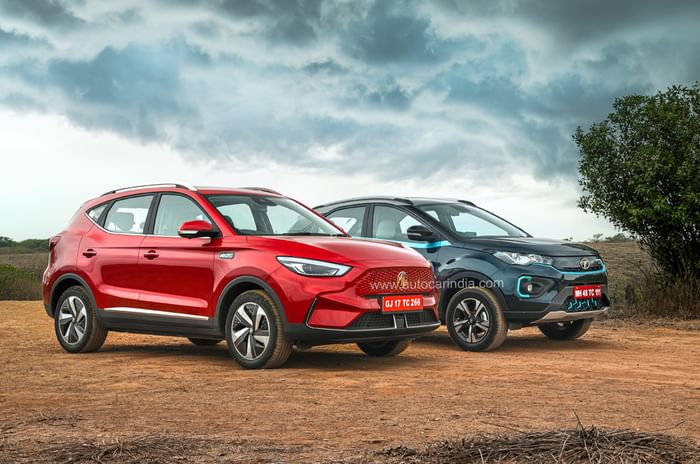
So, we put them both back to back on the same cycle, which included some maddening city traffic, a bit of relaxed highway driving, a few twisties thrown in to sample the ‘Sport’ mode that both of them have, and the results were not too shocking
The Nexon EV Max managed an average range of 263km, which is roughly 55km more than the standard Nexon EV, while the ZS EV, thanks to its larger battery pack, managed 339km which is a very useful 76km advantage over the Nexon Max.
In the city, specifically, the Nexon Max delivers 266km compared to the ZS EV’s 351km, which is an 85km difference. But out on the highway, that gap reduces to 68km, with the Nexon covering 259km compared to ZS EV’s 327km.
DRIVE TO SURVIVE
Engage ‘Sport’ mode and both these EVs see a severe drop in range. That said, performance is brisk and at times even a bit more than necessary. Their handling manners are similar, with neither SUV offering much in terms of thrill and dynamism. But, for what it’s worth, the Nexon’s consistent and weighty steering offers a lot more for driving enthusiasts.

Ride comfort, though, is where the Nexon falls behind. The extra 100kg in kerb weight has led to a retune of the suspension, and the ride, as a result, is on the firmer side. The ZS, meanwhile, is a bit more supple and well cushioned on our broken roads.
However, performance is much closer, and the ZS EV, despite having 176hp (33hp more than the Nexon Max), is faster only by one second. Where the Nexon EV Max clocks 9.4sec for a 0-100kph dash, the ZS EV does it in 8.4sec. That said, off the line response for both EVs is impressive and you’d never really notice the performance difference.
HOLD THAT THOUGHT
What is a clear difference, though, is the way the regenerative braking feels. On the ZS EV, even in its strongest mode, it lacks the resistance you would expect, and the rate of recharging isn’t too impressive either. The Nexon, on the other hand, is more aggressive when engaged into level 3 regen, and in fact it can be used to crawl in stop-go traffic as well. What helps is the one-pedal driving mode where you barely need to use the brakes. Sure, it won’t come to a complete halt, like the Hyundai Kona, but it does work well in toll lines and peak hour traffic.
That said, on both these SUVs, the gain in range using regenerative braking is only decent.

Also, the range numbers will fluctuate depending on the drive mode you are in, selected regen level, road elevation, temperature and, of course, driving style. But for this comparison, we made sure to eliminate as much error as possible by swapping drivers at specific intervals and driving close to each other for similar average speeds.
When it comes to charging, the Nexon has a natural advantage with its smaller-sized battery, which allows for quicker top-ups. Also, since the Max gets the option of a 7.2kW AC fast charger, it is now close to the ZS EV’s battery recharge times. Using a 50kW DC fast charger, Tata says the Nexon EV Max’s battery will go from 0-80 percent in just 56 mins. However, in the real world, its battery management system accepts charge only at around 28-29kW at the most. The ZS, on the other hand, accepts a higher rate of DC charging, usefully reducing the waiting time, offering better range.
| Tested Range and Charging Times | ||
|---|---|---|
| Nexon EV Max | MG ZS EV facelift | |
| - | Range (km) | Range (km) |
| City | 266 | 351 |
| Highway | 259 | 327 |
| Average | 263 | 339 |
| Claimed | 437 (ARAI) | 461 (ICAT) |
| - | 3.3kW AC - 15 hours (10-100%) | 15A portable charger - 18-19 hours (0-100%) |
| - | 7.2kW AC - 6.5 hours (0-100%) | 7.4kW AC - 8.5-9 hours (0-100%) |
| - | 50kW DC - 56 mins (0-80%) | 50kW DC - 60 mins (0-80%) |
SIZE ‘EM UP
Coming to the aesthetics, these two electric SUVs aren’t exactly from the same segment. The Nexon is a compact SUV measuring under four metres, while the ZS EV is a midsize SUV that plays with Creta-sized rivals. So, if space and practicality are to be talked about, the ZS EV has a clear advantage.
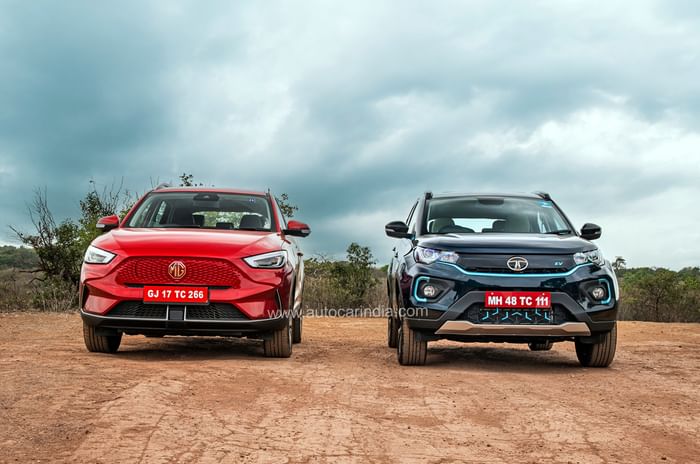
The longer length, wheelbase and taller height give it more road presence, and the overall design is more ‘EV’ than the Nexon, what with the closed-off grille. You also get LED headlamps with DRLs, as opposed to halogen units on the Nexon, larger 17-inch wheels compared to the 16-inch ones on the Tata, and overall a more new-age and modern look. That said, the front-end does split opinion and isn’t to everyone’s taste.

The Nexon, meanwhile, is quite familiar in terms of design. No closed-off grille here, but you get a good dose of blue accents signifying its EV nature. Surprisingly, there isn’t a single badge on the Nexon stating it is a ‘Max’. The only way to figure that out is by zooming into the wheels, which get a different design and rear disc brakes.
INSIDE JOB
On the inside, the differences are, again, quite significant. The Nexon doesn’t feel cramped or uncomfortable, but the extra space in the ZS EV is noticeable. The Nexon Max also gets beige upholstery, which further heightens the sense of space, but the dark interiors of the ZS are surely easier to look after.
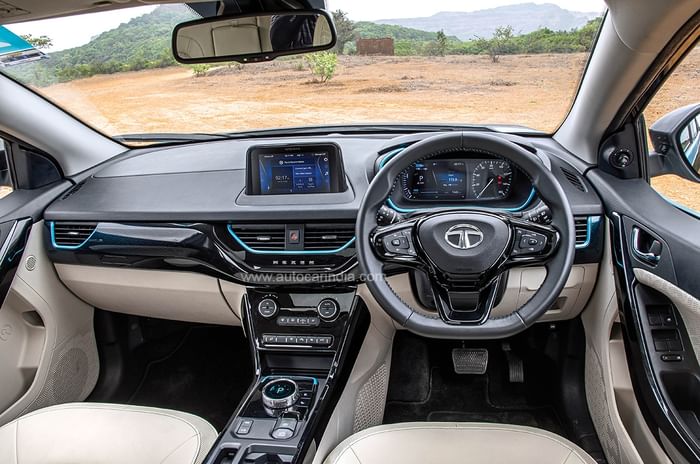
Where the ZS EV edges ahead is in terms of the overall quality. The switchgear and fit-finish are better in comparison to the Nexon and it does have an air of premiumness as well. Sure, the Nexon gets important bits like ventilated front seats, but the ZS EV isn’t too far behind in the features game.
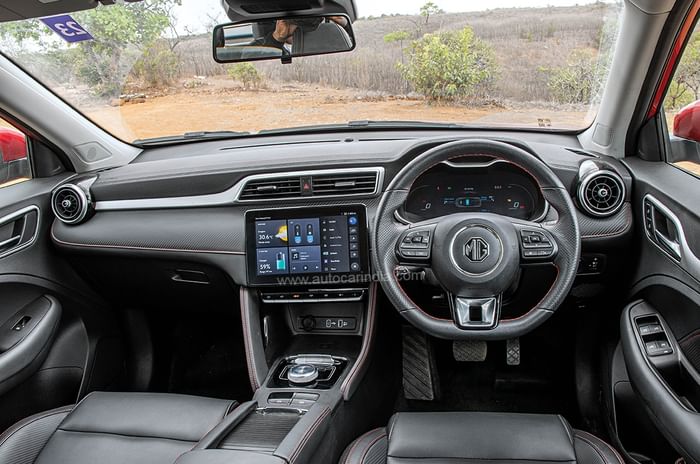
You get a larger touchscreen, at 10.1 inches, with a 360-degree parking camera, a fully-digital instrument cluster that looks more modern than the semi-digital unit, and the big one, a panoramic sunroof that dwarfs the standard sunroof in the Nexon.
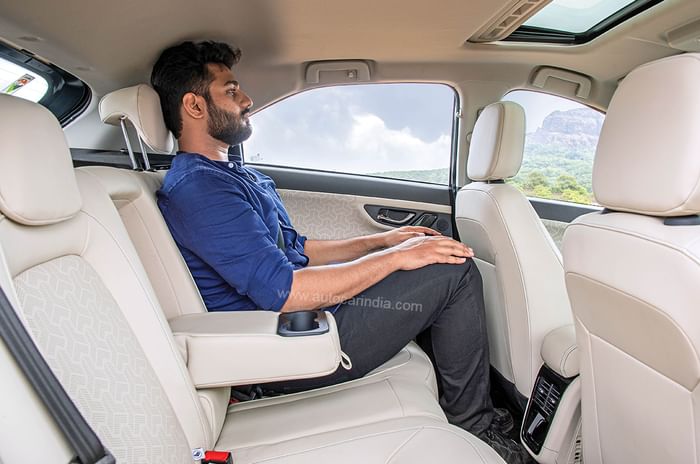
If backseat space is also very important to you, you’d be more comfortable in the ZS EV. The raised floor in the Nexon Max results in rear passengers sitting knees up, and the shorter wheelbase means you won’t be able to stretch as you would in the more spacious ZS EV.

The ZS EV ties with the Nexon EV when it comes to boot capacity, with both measuring at 350 litres and offering a 60:40 split as well. In terms of safety, the Nexon Max gets dual airbags, as opposed to the six on the ZS EV, but the rest of the tech like ABS with EBD, ESP, hill start/descent, and TPMS are present in both.
| Equipment | |||
|---|---|---|---|
| Nexon EV Max | MG ZS EV facelift | ||
| LED headlights | NA | Yes | |
| Auto headlamps/wipers | Yes | Yes | |
| Cruise control | Yes | Yes | |
| Digital instrument cluster | Semi-digital | Yes | |
| Ventilated front seats | Yes | NA | |
| Touchscreen | 7.0-inch | 10.1-inch | |
| Rear view camera | Yes | 360-degree | |
| Wireless phone charger | Yes | Yes | |
| Sunroof | Yes | Panoramic | |
| ESC | Yes | Yes | |
| Blindspot assist | NA | Yes | |
| Airbags | 2 | 6 | |
THE DEFAULT CHOICE
Both these EVs can be your daily drivers, as they have enough range to push out of the urban confines, and comfortably handle that occasional farmhouse trip. However, more than the range, it is the value proposition that plays a crucial role. The MG ZS EV is a no-brainer, until you look at what it costs. The Exclusive variant, which is the top-spec with all the bells and whistles, costs Rs 25.88 lakh. A massive Rs 6.64 lakh premium over the top-spec Nexon EV Max.
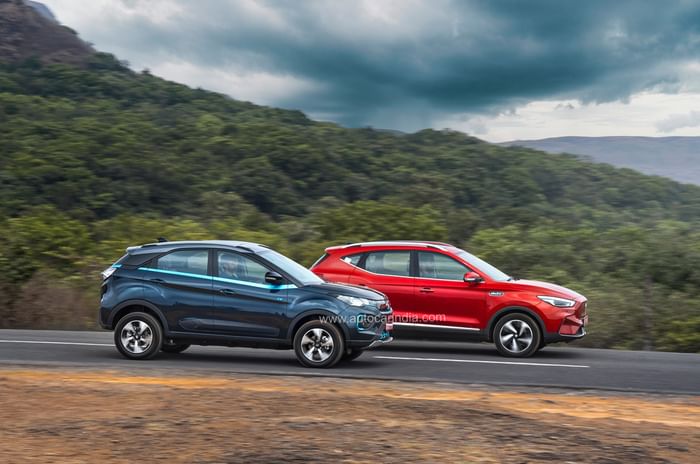
Sure, you get a slightly bigger car with more space on the inside, and a higher range, but paying over Rs 6 lakh for roughly 80km extra is a steep ask. The cheaper Excite trim (Rs 21.99 lakh) of the ZS EV will also be on sale starting July. The warranty though is higher on the MG, with the ZS EV offering 5 years/unlimited km compared to Tata’s 3 years/1,25,000km. And the battery warranty is much closer, with the Tata offering 8 years/1,60,000km and the ZS EV offering 8 years/1,50,000km.
To sum it up then, the Nexon EV Max offers the best balance of everything you would need. It gets all the useful and important features like ventilated seats, wireless charging, a sunroof and fast charging options, along with a healthy range, strong regen and decent performance.
| Price and Verdict | |||
|---|---|---|---|
| Price (ex-showroom, India) | Rs 17.74 lakh-19.94 lakh | Rs 25.88 lakh | |
| Verdict | The best price-to-performance ratio in the EV segment. | A capable and practical EV but expensive | |
| Rating | 8/10 | 8/10 | |
Yes, the MG has better range, but going by the sheer value the Nexon EV Max brings to the table, it is the better buy here and hence the winner of this comparison.









































